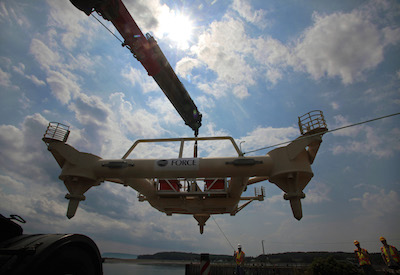Tidal Energy Project’s Underwater Platform Completes Successful Sea Trial

August 25, 2016
After a 27-day sea trial, a team comprising staff at the Fundy Ocean Research Center for Energy (FORCE) and crew members of the Dominion Victory have successfully recovered an underwater monitoring platform, known as FAST-1.
“To explore the energy potential in the Bay of Fundy responsibly, we have to understand it,” says FORCE General Manager Tony Wright. “We’re building a series of subsea instrument platforms that will give us a clearer picture of what’s happening at the FORCE test site.”
The platform was retrieved in mid-July, and analysis of sensor data is now underway. Reliable site data are critical to all aspects of in-stream tidal energy development, including both turbine design and understanding any effects on the marine ecosystem.
The Fundy Advanced Sensor Technology (FAST) program encompasses three separate underwater platforms, onshore radar, meteorological instruments, and a tide gauge. Headlining the program is FAST-1. At 4.5-tonnes and 4-metres in length, this platform is designed for frequent deployment and recovery to enable instrument testing and monitoring. The platform’s current sensor array includes:
- acoustic Doppler current profilers (ADCP) and the Vectron (measuring current speed and turbulence)
- acoustic zooplankton and fish profiler (assessing zooplankton and fish density and depth distribution)
- water quality sensors (measuring water conductivity, temperature, and salinity)
- optical sensor (measuring sedimentation size, distribution and volume concentration using laser diffraction)
- tide, turbidity, and current sensors
- orientation sensor (measuring pitch, roll and heading – crucial to platform placement and the analysis of all other instruments)
“These sensors will add to our understanding of site conditions, including the presence and vertical distribution of fish at the site, and help inform our research and monitoring programs as they continue to evolve,” explains Wright.
FORCE is Canada’s lead test facility for in-stream tidal energy technology, located in the Bay of Fundy. As a not-for-profit research lab, FORCE collaborates with government, industry, academia and the public to better understand if this technology can play a safe, effective role in Canada’s energy future.
Since 2009, FORCE has built the electrical infrastructure to allow in-stream devices to deliver power to the provincial grid, and in partnership with academic and research institutions, invested $15 million in research, monitoring and the Fundy Advanced Sensor Technology program, increasing understanding and scientific knowledge of the Minas Passage. FORCE receives funding support from the Government of Canada, the Province of Nova Scotia, and participating developers.
Photo: Darren Pitmann/ImagesEast.









![Guide to the Canadian Electrical Code, Part 1[i] – A Road Map: Section 52 — Diagnostic imaging installations](https://electricalindustry.ca/wp-content/uploads/2022/11/Guide-CE-Code-2.png)






